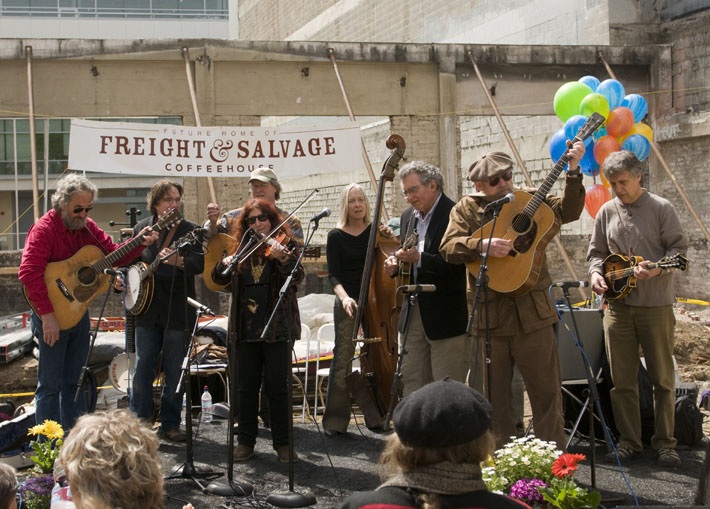 Last night, the Freight & Salvage Coffeehouse — the longest-running, full-time venue for folk and traditional music west of the Mississippi River — opened the doors to its new 18,000 square foot venue on Addison Street in downtown Berkeley with a sparkling concert of Celtic string and vocal music helmed by Scottish fiddler Alasdair Fraser and Californian cellist Nathalie Haas.
Last night, the Freight & Salvage Coffeehouse — the longest-running, full-time venue for folk and traditional music west of the Mississippi River — opened the doors to its new 18,000 square foot venue on Addison Street in downtown Berkeley with a sparkling concert of Celtic string and vocal music helmed by Scottish fiddler Alasdair Fraser and Californian cellist Nathalie Haas.
I don’t want to dwell on the concert itself in this blog post. I’ve written about Fraser and Haas before. I consider these musicians to be among the most sublime practitioners of their art. Perhaps the best way to describe the effect of the music on the audience is to describe what I saw when I looked down the rows of seated spectators: everyone’s toes were tapping and ankles were swaying to the kinetic sound. What I’d like to discuss today is the venue itself.
The opening of a new space for arts is a massive achievement in these trouble financial times. It’s remarkable that the venue managed to launch at all, considering the state of the economy.
The new Freight is in some ways a wonderful space. It’s light and airy. The acoustic is rich — I could make out all the individual layers in the string players’ mix last night, from the careening top notes of the lead fiddle, to the percussive scrapings of the “rhythm” fiddle to the drones of the lower instruments. The room has a bright “ping” to it yet doesn’t swallow any of the vocalists’ words.
The stage is a generous size (1339 square feet) and the space as a whole feels intimate even though it seats double the capacity of the old Freight, which had room for 220 patrons.
Also, you can’t beat the location. The venue is located right in the middle of downtown Berkeley in close proximity to Berkeley Repertory Theatre, The Aurora Theatre, The Jazz School, the University campus and countless great restaurants and bars.
In other ways, however, the new Freight doesn’t appeal to me as a venue for folk music. It feels less like a place to hang out with friends and hear some of the world’s finest folk musicians than it does a medical school lecture theatre. The seats are organized in neat rows which makes the room feel sterile. There should be tables and chairs that can move around, at least towards the front of the auditorium near the stage.
The lighting is spartan and unforgiving and the honey colored wooden walls seem old-fashioned and slightly characterless, like so much 1960s interior design.
There’s quite a bit of room to dance, which is a good thing. But the atmosphere simply isn’t conducive to jumping up and jiggling about. When Fraser suggested that people get up and dance at the end of the performance last night, very few people actually did. I reeled around because I couldn’t help myself and was joined by about three or four other audience members. Everyone else more or less sat or stood still.
Finally, I’m not at impressed with the cafe offerings at all. The tea selection is impressive. But a venue of this size which doesn’t serve alcohol should at least offer a wider and higher quality selection of sweet treats and real hot chocolate rather than fake powdered cocoa.
Postscript: September 2 — This just in from Lisa Manning, the marketing manager at The Freight & Salvage, in response to my blog post:
Chloe,
Interesting that you don’t like the wooden walls- that is one of the aspects of the building that has garnered the most positive comments from patrons. Its wood recycled from the original building here.
Did you come to the community open house on Saturday, August 29th? We had almost 50 workshops, jam sessions in the lobby, and performances in the listening room. I bring it up, because it was a much more interactive environment, in which many people were dancing, and a huge throng were jamming together. The interplay between musicians and audience was dynamic in a way I think you would have appreciated, given your comments about opening night.
The seating has been designed for flexible arrangement to accommodate a variety of performance situations. For a sold-out show, as you saw during the Fiddle Summit, the chairs are in rows without tables. This maximizes the number of patrons that can be seated. Alternatively, the first few rows of chairs can be removed completely, to clear out an ample dance floor in front, for performances which encourage dancing. For a more casual & smaller performance, we can intersperse chairs & tables.
Finally, the café offerings are certainly a work in progress and you should expect to see changes in our offerings over the coming months.
I’ll share your write-up with other members of our staff.
Regards,
Lisa
